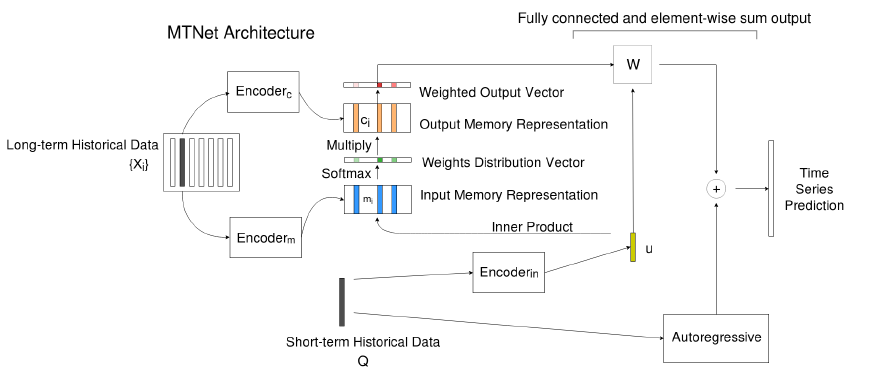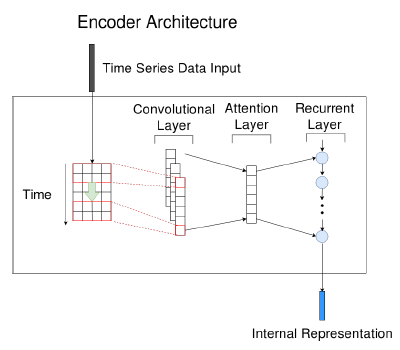DeepHit : A Deep Learning Approach to Survival Analysis with Competing Risks
Contents
- Abstract
- Introduction
- Framework
- Problem Formulation
- Memory Time-series Network
0. Abstract
RNN :
- unable to capture “extremely long-term patterns”
- lack of explainability
propose a MTNet (Memory Time-series Network)
-
consists of…
- 1) large memory component
- 2) three separate encoders
- 3) autoregressive components
\(\rightarrow\) train jointly
1. Introduction
Previous Works
-
Attention based encoder : remedy to vanishing gradient problem
-
LSTNet : solution for MTS
-
1) Convolutional Layer & Recurrent Layer
-
2) Recurrent skip : capture long-term dependencies
-
3) incorporates
- (1) traditional autoregressive linear model
- (2) non-linear NN
-
downside : predefined hyperparameter in Recurrent skip
\(\rightarrow\) replace Recurrent skip with “Temporal attention layer”
-
-
DA-RNN (Dual-stage Attention based RNN)
- step 1) attention : extract relevant driving series
- step 2) temporal attention : select relevant encoder hidden states across all time steps
- downside 1) does not consider spatial correlations among different components of exogenous data
- downside 2) point-wise attention : not suitable for capturing continuous periodical patterns
MTNet (Memory Time-series Network)
Exploit the idea of MEMORY NETWORK
propose a TSF model, that consists of..
-
1) memory component
-
2) 3 different embedding feature maps
( generated by 3 encoders )
-
3) autoregressive components
Calculate similarity between “input & data in memory”
\(\rightarrow\) derive “attentional weights” across all chunks of memory
Incorporate traditional autoregressive linear model
Attention :
- [DA-RNN, LSTNet] attention to particular timestamps
- [proposed] attention to period of time
2. Framework
(1) Problem Formulation
Notation
- MTS : \(\boldsymbol{Y}=\left\{\boldsymbol{y}_{1}, \boldsymbol{y}_{2}, \ldots, \boldsymbol{y}_{T}\right\}\)
- \(\boldsymbol{y}_{t} \in \mathbb{R}^{D}\), where \(D\) : # of dimension (TS)
- predict in “ROLLING forecasting fashion”
- input : \(\left\{\boldsymbol{y}_{1}, \boldsymbol{y}_{2}, \ldots, \boldsymbol{y}_{T}\right\}\)
- output : \(\boldsymbol{y}_{T+h}\)
(2) Memory Time-series Network
Input :
-
1) long-term TS : \(\left\{\boldsymbol{X}_{i}\right\}=\boldsymbol{X}_{1}, \cdots, \boldsymbol{X}_{n}\)
-
to be stored in memory
-
2) short-term TS : \(Q\)
\(\rightarrow\) \(X\) & \(Q\) are not overlapped
Model
- 1) put \(\boldsymbol{X}_{i}\) inside (fixed-size) memory
-
2) embeds \(\boldsymbol{X}\) and \(Q\) into a (fixed length) representation
-
with \(\text{Encoder}_m\) & \(\text{Encoder}_{in}\)
-
3) Attention : attend to blocks stored in the memory
- inner product of their embedding
-
4) use \(\text{Encoder}_{c}\) to obtain the context vector of the memory \(X\)
& multiply with attention weights \(\rightarrow\) get “weighted memory vectors”
-
5) concatenates …
- (1) weighted output vectors
- (2) embedding of \(\boldsymbol{Q}\)
\(\rightarrow\) feed as input to a dense layer
-
6) final prediction : sum the output of
- (1) NN
- (2) AR model

(a) Encoder Architecture

- input : \(X \in \mathbb{R}^{D \times T}\)
- use CNN w.o pooling
- to extract (1) short-term patterns in time dimension & (2) local dependencies between variables
- multiple kernels with
- size \(w\) in time dimension
- size \(D\) in variable dimension
(b) Input Memory Representation
- input : long-term historical data \(\left\{\boldsymbol{X}_{i}\right\}=\boldsymbol{X}_{1}, \cdots, \boldsymbol{X}_{n}\)
- where \(\boldsymbol{X}_{i} \in \mathbb{R}^{D \times T}\)
- output : \(\boldsymbol{m}_{i}\) … where \(\boldsymbol{m}_{i} \in \mathbb{R}^{d}\)
- entire set \(\left\{\boldsymbol{X}_{i}\right\}\) are converted into input memory vectors \(\left\{\boldsymbol{m}_{i}\right\}\)
- ( short-term historical data \(\boldsymbol{Q}\) is also embedded via another encoder, and get \(\boldsymbol{u}\) )
Notation
- \(\boldsymbol{m}_{i} =\operatorname{Encoder}_{m}\left(\boldsymbol{X}_{i}\right)\).
- \(\boldsymbol{u} =\operatorname{Encoder}_{i n}(\boldsymbol{Q})\).
Compute the match between..
- (1) \(\boldsymbol{u}\)
- (2) each memory vector \(\boldsymbol{m}_{i}\)
\(\rightarrow\) \(p_{i}=\operatorname{Softmax}\left(\boldsymbol{u}^{\top} \boldsymbol{m}_{i}\right)\)
(c) Output Memory Representation
context vector : \(\boldsymbol{c}_{i}=\operatorname{Encoder}_{c}\left(\boldsymbol{X}_{i}\right)\)
weighted output vector : \(\boldsymbol{o}_{i}=p_{i} \times \boldsymbol{c}_{i}\) …… where \(\boldsymbol{o}_{i} \in \mathbb{R}^{d}\)
(d) autoregressive component
\(\boldsymbol{y}_{t}^{D}=\boldsymbol{W}^{D}\left[\boldsymbol{u} ; \boldsymbol{o}_{1} ; \boldsymbol{o}_{2} ; \cdots ; \boldsymbol{o}_{T}\right]+\boldsymbol{b}\).
(e) final prediction
integrating the outputs of the (1) NN & (2) AR
- \(\hat{\boldsymbol{y}}_{t}=\boldsymbol{y}_{t}^{D}+\boldsymbol{y}_{t}^{L}\).
Loss Function : MAE
- \(\mathcal{O}\left(\boldsymbol{y}_{T}, \hat{\boldsymbol{y}}_{T}\right)=\frac{1}{N} \sum_{j=1}^{N} \sum_{i=1}^{D} \mid \left(\hat{\boldsymbol{y}}_{T, i}^{j}-\boldsymbol{y}_{T, i}^{j}\right) \mid\).
